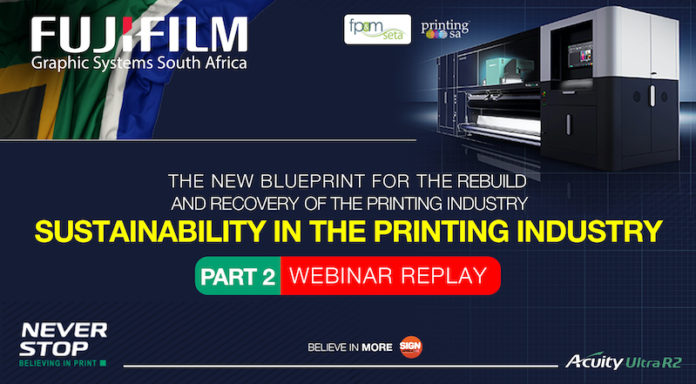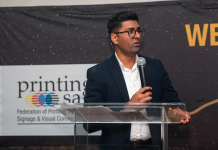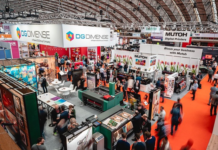In part 2 of ‘The New Blueprint for the Rebuild and Recovery of the Printing Industry’ webinar series, participants discussed insights and feedback from Printing SA’s recent engagements with the Government on how their members have been directly affected and some of the measures being implemented in order to rebuild and recover. They also discussed sustainability issues affecting the industry and the blueprint for the industry going forward.
This live event was sponsored by FUJIFILM Graphic Systems and Acuity Ultra R2 in partnership with Printing SA and FP&M SETA.
Discussion panel members
– FUJIFILM Graphic Systems: General Manager – Grant Potgieter.
– FUJIFILM Graphic Systems: Product Manager, Wide Format – Anja Kirton.
– Printing SA: CEO – Dr. Abdool Majid Mahomed.
– FP&M SETA: CEO – Dr. Felleng Yende.
– FP&M SETA: General Manager, planning, report and research – PK Naicker.
How is FP&M SETA supporting the printing industry through this apt phrase ‘rebuild and recovery’ that Fujifilm has coined for what we have been going through? What is your strategy for the sector in the next year or two?
Naicker
An issue like sustainability has to be informed and underpinned by strategy, thus industry must ensure that they have a proper growth strategy and a master plan in place. Back in 2013 when Dr. Yende was appointed by FP&M SETA, she said that all other FP&M industries have growth strategies in place and noticed this gap in the printing and packaging industry.
What has happened since then is that in ensuring the future sustainability of the industry, we have partnered both with Printing SA and the South African Typographical Union (SATU) in putting research in place, because we believe that to ensure that the industry becomes innovative, this must be informed by research, which will also address key pillars of a future growth strategy.
If you look at the printing and packaging industry, we are quite high up in technology and productivity. We are also looking at future sustainability of the industry from a waste management perspective, so we’ve got to ensure that we embed greener production in all of our occupational trades. The strategy must also address competitiveness and improvement of the industry.
Skills development must be a separate pillar. These are key pillars that should inform your strategy going forward.
Can you comment on the long-term sustainability of the sector?
Dr AM Mahomed
With the master plan process, we’ve had some serious engagements with the Department of Trade, Industry and Competition (DTIC) and they have some master plans for various sectors in the manufacturing domain. They are now beginning to take our sector seriously. We made a presentation at the Presidency’s office meeting that monitors progress on all master plans, and they have agreed that our master plan process should go ahead with its planning.
Then from another Department’s side as well, from the Department of Small Business Development (DSBD) and the Department of Sports, Arts and Culture (DSAC) – they have developed what is called a Creative Sector master plan, and we are one of four sub-sectors playing a key role in terms of printing and publication.
The aim of the master plan is to look at re-energising the sector in terms of exports and imports, looking at local job creation, sustainable investments from overseas as well as locally, and also to ensure localisation of content in that work is done in this country rather than abroad. We are also hoping to play a big role in the South African Development Community (SADC), the African Union and the African Continental Free Trade Agreement (AcFTA) in terms of getting inroads into the rest of the continent.
In terms of the industry growth strategy, we’ve been very grateful for the help of the FP&M SETA. They have sponsored various top level research that was commissioned by SATU, who asked the Institute of Futures Research to paint a picture of what the future is going to look like and what skills employees will be required to have.
BMI was tasked to look at a report on behalf of Printing SA of what the sector is about, and what the sector really needs.
What is your advice for businesses?
Potgieter
The key for businesses is that everyone just needs to take a step back and take a holistic review of their business. Review the full supply chain, from the beginning to end, and the entire business process: your relationship with procurement, understanding their suppliers and their sourcing initiatives that they have in place and how they are sourcing and where they are sourcing from.
You’ve got to look at the workflow processes in your business – how do you streamline those processes with the aim of reducing waste? Technology and workflow solutions are critical in any business. Continually invest in technologies to grow your business, to make it more efficient and to reduce energy consumption.
Waste management is obviously key, we speak to that all the time – the paper, the substrates, what you are doing with that once you are done, the offcuts of that waste and how you are disposing of the inks and the aluminium. What have you got in place regarding recycling? There are many initiatives of that nature that businesses have to start looking at.
Energy management and CO2 emissions are at the forefront for Fujifilm globally. We’ve extended our targets to reduce our CO2 emissions by 40% globally by 2030. Training and education is an ongoing process, not only for our staff, suppliers and customers but consumers. We are finding ways to continue that education programme and emphasise the importance of sustainability.
How is the FP&M SETA’s medium and long-term strategy going to fill the skills void in the market, especially for the print sector?
Naicker
We have had continuous discussions and very focused workshops with the printing industry etc. where we addressed the issues in terms of future and emerging skills – something that we really need to be serious about and look into. We continuously draw up sectorial occupations that are in high demand and whenever we do that obviously we expect the industry to assist us by projecting what would be the future emerging skills in a couple of years down the line that would create jobs.
When we talk about occupations in demand, we would ask what would keep current employers in employment and what would create jobs for the unemployed. But what we also must stress upon is that we need to continuously upskill and multi-skill the workforce.
We have to ensure that the workforce has got portable skills that can be reproduced across various industry sub-sectors. We focus on a flexible workforce. People must be able to multi-task and there must be a knowledgable workforce.
If you want to ensure that your business is competitive and sustainable, digitisation, Industry 4.0, robotics, automation and AI are some of the skills and the future occupations that are identified in the Future Jobs Report and the International Labour Organisation (ILO) Reports – this is what would make you competitive and remain in employment in 5-10 years’ time.
What is Printing SA doing about protecting the industry legislatively?
Dr. Mahomed
The government has played a key role in enacting some regulations that have impacted on our industry at large, including:
The Waste Management Act, which was recently promulgated, is now in place since 5 November 2021. The aim is to minimise landfills and to encourage the circular economy. The Act states that the producer is obliged to register with the Department of Environment, Forestry and Fisheries and pay extended producer responsibility fees to a Producer Responsibility Organisation (PRO), and anything that is produced in excess of ten tonnes is liable for a payment to a PRO.
The Air Quality Act: any owner in the printing industry needs to ensure that any emissions that exceeds 25 tonnes per annum will need to put in mitigation equipment at huge costs, either carbon absorption and/or thermal oxidisers. Printing SA has on behalf of the industry made representation suggesting alternatives to how the proposed legislation could be effected, and the Department of Forestry, Fisheries and the Environment are giving consideration to our recommendations.
The National Climate Bill, which is still being fine-tuned, also needs to be considered.
How is the FP&M SETA gearing up to ensure the skills within our industry will continue to be relevant according to what the global migration of skills will be?
PK Naicker
When I look at the industry, the sector specific trades and all of them have been aligned and updated (in terms of qualifications), meeting the regulatory compliance of the Quality Council for Trades and Occupations (QCTO) and South African Qualifications Authority (SAQA) requirements.
What is critical is that when these qualifications are getting updated, one has got to ensure that they remain relevant, are fit for purpose, that they address embedded issues and that young learners will be able to understand the consequences of (for example) waste management, and what it would mean to the industry. They need to understand how irresponsible behaviour would result in the industry suffering and becoming less sustainable.
We are also addressing the matters by way of the Economic Recovery and Reconstruction Programme (ERRP) that prioritises economic recovery, sustainability and growth within the various industries. Through this programme we address innovation, entrepreneurship and Industry 4.0, etc. because this is what we believe will contribute to the growth and sustainability of all of our industries.
We are urging our key stakeholders and employer organisations and associations etc. to come up with such projects where we look at those type of skills.
What are some of the pain points that you find with customers, where you are trying to drive them to change their thought process into becoming more environmentally friendly, as well as being more productive and making the cost a lot less?
Potgieter
We need to look at the bigger picture – what equipment you are investing in, what consumables you are using and what the repercussions of these consumables are. Fujifilm’s focus has always been very green with consideration given to a sustainable future, not just money-wise but for the environment as well. Customers need to align with the suppliers that will supply the right equipment and consumables, and lean on them for advice.
Do you have any programmes in place that will help small businesses diversify their operations so that they become not only more environmentally sustainable but sustainable as a business?
Potgieter
As a global organisation, we have many initiatives in place, such as our Plate Sense Programme. From an ink disposal perspective, this is the sort of education needed, because sadly ink does get dumped down the drain by certain businesses.
Some of the key initiatives we need to bring in the new year is putting together a training academy – an initiative to encourage new entrants into the industry, with new ways of thinking, and sustainability being the key focus. We need to listen to consumers and find ways to develop better innovations, and we can only do that in conjunction with our customers and with the likes of the industry bodies.
What is the impact of green washing and how we can mitigate the effects?
Dr. Mahomed
Two Sides tries to improve standards and practices that promote the sustainability of the graphics and communications industry at large, such as dispelling misconceptions about paper being bad for the environment. Companies promoting digital over paper use green washing to make claims about their eco-friendliness, and Two Sides counteracts these false claims. Paper is one of the best and highly recyclable from all substrates used.
We want to work with SAPO, as an improvement in postal delivery will impact positively on companies wanting to use their services.
Dr. Yende
There are a lot of myths surrounding paper. We need a campaign where we can showcase the benefits of embracing both markets, and try and repel the myth that suggests that paper releases a lot of CO2 into the environment. In the printing sector, we have a lot of interventions that are meant to address the issues of a clean environment. Remember paper comes from a process of forestry, from the trees that we have, in a safe and clean way. We have an opportunity to educate the public about this.
Summarising the Industry Blueprint
Dr. Mahomed
One thing that comes out very clearly from COP26 is the need for industry to look at carbon calculators, i.e what is the impact of the machinery and equipment being used, and the resulting carbon emissions, and how these can be lessened.
Companies that are on the verge of purchasing new equipment also need to look at their carbon footprint and emissions, to make wise choices in terms of a cost benefit analysis.
We also need to ensure companies are using paper and board that are Forest Stewardship Council (FSC) Certified, as well as eco-friendly inks. We should also look at the recyclability of the items that are manufactured, from the design stage to the end of its life.
Naicker
In terms of greener production and waste management, these are key issues in all industries. From a skills development perspective, we need to ensure that there is a greater advocacy for a greener production going forward.
We have to embrace and embed these within our qualifications framework, such as managing waste paper and effluent from ink run off that goes into the drains. These are key issues that can be managed through qualifications development and our learning system within the printing, packaging and signage industries.
Potgieter
Sustainability has always been at the core of Fujifilm as a business. It will remain so and we will continue to innovate in that space. Locally and globally we have been a leader and we will continue to look at ways to improve, to grow and to educate.
Those that have sustainability as a core focus will reap the benefits in the long run. The circular economy needs to be front of mind – the type of equipment that you’re buying, the consumables that you’re putting through that machine and what you’re doing with it from a waste management perspective need to be key focuses in your business.
Kirton
One of the questions we have to ask is: how do we as a supplier to the print industry think even more sustainably so we can also support the print manufacturers and take on these initiatives? In this formulation of the blueprint, Fujifilm’s answer to this is the Acuity Ultra R2.
The printer is designed on sustainability principles. There is the UV LED option, which can save you up to 50% energy consumption. Both ink sets have GreenGuard certifications, and we will continue building sustainable equipment and consumables across the whole spectrum.
The Acuity Prime and Acuity Ultra R2 offers more for less, allowing users to do more, with less. Using printers of the best quality, with the right capabilities, means more output with less input. These products also aim to help businesses achieve their sustainability objectives, which is vital in today’s market.
Watch the full webinar below:
|
LOCAL DISTRIBUTOR |















